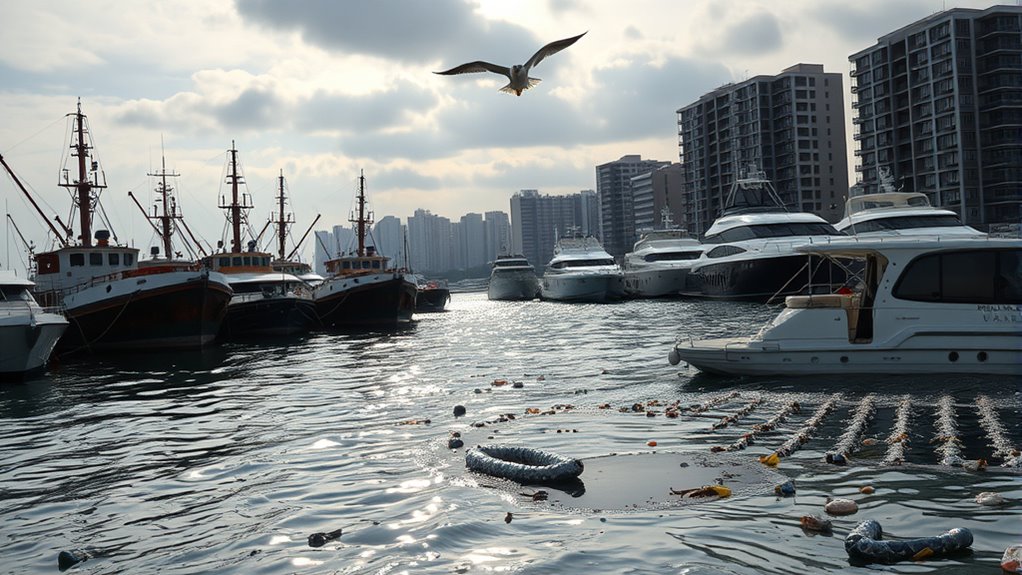Harbor and urban shorelines are crucial for transportation, recreation, and ecological health, but pollution and safety hazards threaten these areas. Marine debris, chemicals, and oil can clog waterways, damage infrastructure, and harm wildlife, while erosion and pollution pose risks to visitors and communities. Effective cleanup, pollution reduction, and shoreline restoration efforts are essential to protect these zones. Keep exploring to discover more ways you can help safeguard and preserve these valuable coastal environments.
Key Takeaways
- Pollution from plastics, chemicals, and debris threatens marine ecosystems and human health along harbor and urban shorelines.
- Marine debris can obstruct waterways, damage boats, and pose hazards to swimmers and marine life.
- Shoreline restoration efforts focus on debris removal, native vegetation replanting, and reinforcing natural barriers.
- Proper waste disposal, recycling, and community cleanup initiatives are vital for maintaining safety and reducing pollution.
- Preserving shoreline ecosystems helps prevent erosion, protect infrastructure, and ensure safer, cleaner coastal environments.

Have you ever wondered how harbor and urban shorelines shape our cities and environments? These areas are essential interfaces between land and water, serving as hubs for transportation, commerce, and recreation. But they also face significant challenges, especially when it comes to pollution and safety. One of the most visible issues is marine debris—floating plastics, abandoned fishing gear, and other waste that accumulates along the shoreline. This debris not only spoils the natural beauty but also threatens marine life, wildlife, and even human health. When debris washes ashore, it can cause injuries to animals or be ingested, leading to injury or death. As a city dweller or visitor, you might notice how marine debris clutters beaches and harbors, diminishing the appeal and posing hazards for swimmers and boaters alike.
Addressing these problems requires intentional efforts like shoreline restoration, which aims to repair and stabilize damaged coastlines. Shoreline restoration involves removing debris, replanting native vegetation, and reinforcing natural barriers like dunes or mangroves. These measures not only improve the aesthetic quality of the shoreline but also create a buffer zone that helps prevent further pollution from reaching inland areas. Restoring the shoreline also reduces erosion, which can be exacerbated by human activity and climate change, protecting infrastructure and ecosystems alike. When you participate in or support shoreline restoration projects, you help restore the natural functions of these environments, making them safer and more resilient.
Supporting shoreline restoration helps repair coastlines, reduce erosion, and create natural buffers to prevent pollution and protect ecosystems.
Safety on harbor and urban shorelines is closely tied to managing pollution. Marine debris can clog waterways, damage boats, and create dangerous conditions for navigation. Moreover, pollutants like oil, chemicals, and plastics can leach into the water, contaminating local seafood and affecting public health. That’s why local governments and community groups often organize cleanup events. These efforts are essential because they prevent debris from accumulating further and reduce the risks posed to people and wildlife. Your involvement—whether through volunteering or advocating for stricter waste management policies—can make a tangible difference. Proper waste disposal, recycling, and reducing single-use plastics are simple actions you can take to lessen the burden on these fragile environments.
Ultimately, harbor and urban shorelines are dynamic spaces that require ongoing care. Combating marine debris and investing in shoreline restoration are necessary steps to maintain safer, cleaner, and more sustainable cities. When you understand the impact of pollution and the importance of restoration, you become part of the solution—helping to preserve these essential coastal zones for future generations.
Frequently Asked Questions
How Do Pollution Levels Vary Seasonally Along Urban Shorelines?
You’ll notice pollution levels along urban shorelines fluctuate seasonally, primarily due to seasonal runoff and algae blooms. During heavy rains, runoff carries pollutants into the water, increasing contamination. Warmer months promote algae growth, which can deplete oxygen and worsen pollution. So, in summer, pollution spikes often coincide with algae blooms, while winter sees lower levels due to reduced runoff. Staying aware of these patterns helps you better understand shoreline safety and pollution risks.
What Are the Long-Term Health Impacts of Shoreline Pollution?
Long-term health impacts of shoreline pollution can include chronic respiratory issues, skin problems, and increased risk of infections due to ongoing pollution exposure. You might also face long-term consequences like cardiovascular problems from sustained contact with contaminated water or air. Prolonged pollution exposure weakens your immune system and can lead to serious illnesses over time, emphasizing the importance of monitoring and reducing shoreline pollutants for your health and safety.
Are There Effective Community Programs for Shoreline Pollution Cleanup?
You might think shoreline cleanup is solely about environmental health, but community programs prove otherwise. Volunteer initiatives and community engagement are surprisingly effective at tackling pollution. They foster local pride, promote awareness, and create a sense of shared responsibility. So, yes, many programs exist—empowering residents to make a tangible difference. It’s ironic how grassroots efforts often outperform top-down regulations, proving that collective action can restore our polluted shorelines.
How Do Urban Shoreline Safety Standards Differ Internationally?
International safety standards for urban shorelines vary widely due to differing regulatory frameworks and safety protocols. In some countries, strict regulations require vital safety measures like barriers, signage, and regular inspections. Others have more relaxed standards, which might lack consistent enforcement. You should always check local regulations before visiting or working near urban shorelines, as adherence to safety protocols is essential for your protection and environmental health.
What Innovative Technologies Are Emerging to Monitor Shoreline Pollution?
You should explore emerging sensor innovations like drone-based sensors and autonomous water monitors that provide real-time data on shoreline pollution. These technologies use advanced data analytics to identify pollution hotspots quickly, enabling prompt responses. By integrating AI-driven insights, you can improve shoreline safety and pollution management, making shoreline monitoring more efficient, accurate, and proactive. These innovations are transforming how communities protect urban shorelines from pollution threats.
Conclusion
As you walk along harbor and urban shorelines, remember that pollution threatens these vibrant spaces just like it did during the Industrial Revolution. You have the power to make a difference—from proper waste disposal to supporting green initiatives. Don’t let today’s modern challenges turn your favorite spot into a scene from a dystopian novel. By staying vigilant and proactive, you can help preserve these shores for future generations—and maybe even enjoy them without a commie drone overhead.










